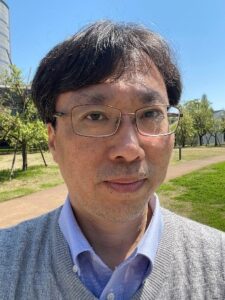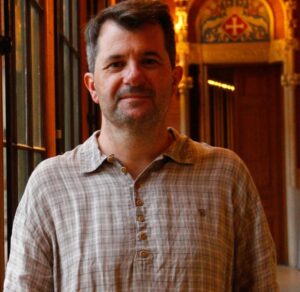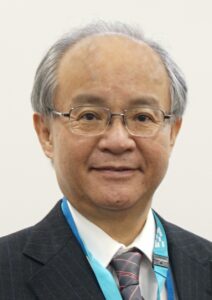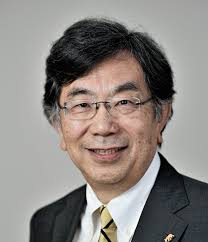Keynote Speakers
Naoyuki Kubota, Ph.D Professor in the Department of Mechanical Systems Engineering, the Graduate School of Systems Design, Tokyo Metropolitan UniversityDirector of Community-centric Systems Research Center, Tokyo Metropolitan University, Japan. |
 |
Abstract:
Biography:
Naoyuki Kubota is currently a Professor in the Department of Mechanical Systems Engineering, the Graduate School of Systems Design, and Director of Community-centric Systems Research Center, Tokyo Metropolitan University, Japan. He received a doctoral degree from Nagoya University, Japan, in 1997. He joined Osaka Institute of Technology and Fukui University, Japan. He was an Associate Professor from 2005 to 2012, and a Professor from 2012 at the Graduate School of Systems Design, Tokyo Metropolitan University, Japan. He was a Visiting Professor at University of Portsmouth, UK and Seoul National University, and others. His current interests are in the fields of topological mapping, coevolutionary computation, spiking neural networks, robot partners, and informationally structured space. He has published more than 500 refereed journal and conference papers in the above research fields. He was an associate editor of the IEEE Transactions on Fuzzy Systems from 1999 to 2010, the IEEE CIS Intelligent Systems Applications Technical Committee, Robotics Task Force Chair from 2007 to 2014, IEEE Systems, Man, and Cybernetics Society, Japan Chapter Chair from 2018 to 2021, IEEE Transactions on Affective Computing Steering Committee Member since 2019, and others.
Guillem Alenyà, Ph.D Researcher and Director at the Institut de Robotica i Informàtica Industrial (IRI) |
 |
Abstract:
Biography:
Guillem Alenyà is Researcher and Director at the Institut de Robotica i Informàtica Industrial (IRI), a joint centre of the Spanish Scientific Research Council (CSIC) and Polytechnic University of Catalonia (UPC). He received a PhD degree (Doctor Europeus) from UPC in 2007 with a work on mobile robot navigation using active contours, which he partly developed at the Robosoft company in France, where he was supported by a EU-FP6 Marie-Curie scholarship. He has been visitor at KIT-Karlsruhe (2007), INRIA-Grenoble (2008) and BRL-Bristol(2016). He has participated in numerous scientific and technological transfer projects involving image understanding, next-best-view, rule learning from human examples and planing execution tasks. His current research is devoted to facilitate the introduction of robots in human environments, principally in the fields of assistive robotics and garment manipulation. He is coordinator of various projects on developing enabling technologies for assistive robotics: ROB-IN about personalization and explainability, CLOE-GRAPH about high-level representation of tasks and explainability (coIP J. Borras), and principal investigator in the SeCuRoPS project, about privacy and safety in HRI, and BURG, about benchmarking and repeteability. He has been coordinator of the SIMBIOTS project on cooperative robots and HuMoUR (on human-to-robot skills transfer, co-IP F. Moreno), and principal investigator of the SOCRATES project (on quality of interaction for social robots).
| Humanoid Robotics Research and Its Applications
Prof. Atsuo Takanishi Professor in the Department of Modern Mechanical Engineering Waseda University Director of the Humanoid Robotics Institute, Waseda University, Japan. |
 |
Abstract:
Biography:
ATSUO TAKANISHI is the Department Head and a Professor of the Department of Modern Mechanical Engineering as well as the director of the Humanoid Robotics Institute, Waseda University. He received the B.S.E. degree in 1980, the M.S.E. degree in 1982 and the Ph.D. degree in 1988, all in Mechanical Engineering from Waseda University. His research projects are related to Humanoid Robotics and its applications in medicine and well-being, such as the biped walking/running/baseball-pitcher humanoids, the emotion expression humanoids, the flute/saxophone player and musical conductor humanoids, the ultrasound medical inspection robots, the patient simulation humanoids for airway management training, disaster response humanoids, etc.
He was the former President of the Robotics Society of Japan (RSJ) from 2015 to 2016 and is the Chairman of the Japanese Council of the International Federation for the Promotion of Mechanism and Machine Science (Jc-IFToMM). He is a member of many robotics and medicine related academic societies and governmental committees such as IEEE, RSJ, and the Society of Mastication Systems, the Robot Revolution Initiatives, and a Vice President of the Fukuoka Prefectural Robotics and Advanced System Industry Development Council, etc. He is a fellow of RSJ, the Japanese Society of Mechanical Engineers (JSME) and a senior member of IEEE.
He received the RSJ Best Journal Paper Award (1998), RSJ/JSME ROBOMECH Award (1998), BusinessWeek Best of Asia Award (2001), IROS2003 Best Paper Award –Application (2004), JSME Best Journal Paper Award (2006), ROBIO2007 Best Conference Paper Award (2007), RSJ Advanced Robotics Best Paper Award (2015) and many more domestic and international awards.
| Autonomous Intelligent and SWARM Control of Robots in Harsh Environment
Prof. Masayoshi Tomizuka Jr. Distinguished Professor of National Academy of Engineering Cheryl and John Neerhout Department of Mechanical Engineering University of California, Berkeley |
 |
Abstract:
Natural disasters are recurring events. In Japan, such disasters occur due to earthquakes, tsunamis, landslides, typhoons, and so on. Current practice of disaster response includes warning by the Meteorological Agency, information dissemination by media (SNS, Internet, TV, Radio…) and rescue operation by Fire and Disaster Management Agency, National Police Agency and Japan Ground Self-Defense Force. Robots have been utilized in many ways such as exploration and searching in spaces too narrow for humans to enter, investigation in lieu of humans in dangerous areas, assessment of damage status, air delivery of foods and medicines by drones, and so on. The usage of robots and drones, however, have not been fully exploited. It is desired to rescue as many victims as possible during the first 72 hours after the occurrence of disaster. The Fukushima Institute for Research, Education and Innovation (commonly known as F-REI) is a special corporation established on April 1, 2023 under the Act on Special Measures for the Reconstruction and Revitalization of Fukushima. Fukushima was hit hard by the Great East Japan Earthquake on March 11, 2011 followed by tsunami and serious damages of the Fukushima Daiichi nuclear disaster. Division 1 (Robotics) of F-REI is engaged in research and development of robots and drones more deployable to a larger set of disasters. Research and development efforts of this unit are directed to 1) collaborative control of synergistic use of UAVs (Unmanned Aerial Vehicles) and UGVs (Unmanned Ground Vehicles) to share roles and respond to various tasks during disasters, 2) collaborative system between UAV/UGV robot groups and humans, and 3) AI technologies to support coordinated control and collaborative systems. Progresses made by principal members of the unit will be reported along with the demonstration planned for the spring of 2026.
Biography:
Masayoshi Tomizuka (Life Fellow, IEEE) was born in Tokyo, Japan, in 1946. He received the B.S. and M.S. degrees in mechanical engineering from Keio University, Tokyo, in 1968 and 1970, respectively, and the Ph.D. degree in mechanical engineering from the Massachusetts Institute of Technology, Cambridge, MA, USA, in 1974.,In 1974, he joined the Faculty of the Department of Mechanical Engineering, University of California at Berkeley, Berkeley, CA, USA, where he is currently the Cheryl and John Neerhout, Jr., Distinguished Professorship Chair and teaches courses in dynamic systems and controls. From 2002 to 2004, he was the Program Director of the Dynamic Systems and Control Program of the Civil and Mechanical Systems Division of NSF. His current research interests include optimal and adaptive control, digital control, signal processing, motion control, and control problems related to robotics, machining, manufacturing, information storage devices, and vehicles.Dr. Tomizuka was the Technical Editor of the ASME Journal of Dynamic Systems, Measurement and Control (J-DSMC) (1988–1993), Editor-in-Chief of IEEE/ASME Transactions on Mechatronics (1997–1999), and an Associate Editor for the Journal of the International Federation of Automatic Control, and Automatica. He was the General Chairman of the 1995 American Control Conference, and was the President of the American Automatic Control Council (1998–1999). He is a Life Fellow of the ASME and a Fellow of the International Federation of Automatic Control (IFAC) and the Society of Manufacturing Engineers. He was the recipient of the Best J-DSMC Best Paper Award (1995 and 2010), DSCD Outstanding Investigator Award (1996), Charles Russ Richards Memorial Award (ASME, 1997), Rufus Oldenburger Medal (ASME, 2002), John R. Ragazzini Award (AACC, 2006), Richard E. Bellman Control Heritage Award (AACC, 2018), Honda Medal (ASME, 2019), and Nathaniel B. Nichols Medal (IFAC, 2020). He is a member of the National Academy of Engineering.
